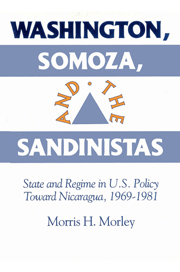Book contents
- Frontmatter
- Contents
- Acknowledgments
- 1 Introduction: Permanent and transitory interests in U.S. foreign policy
- 2 Washington and the Somoza dynasty: From consolidation to crisis of a client dictatorship
- 3 Supporting Somoza: Substance and symbol in American policy during the Nixon-Ford era
- 4 The Carter administration and Nicaragua: Human rights and the politics of accommodation
- 5 The Carter administration and Nicaragua: Mediation and the politics of frustration
- 6 Washington ruptures a historic relationship: Dumping the dictator to save the state
- 7 The Carter administration and revolutionary Nicaragua: Containing Sandinista power
- 8 Conclusion
- Bibliography
- Index
4 - The Carter administration and Nicaragua: Human rights and the politics of accommodation
Published online by Cambridge University Press: 31 March 2010
- Frontmatter
- Contents
- Acknowledgments
- 1 Introduction: Permanent and transitory interests in U.S. foreign policy
- 2 Washington and the Somoza dynasty: From consolidation to crisis of a client dictatorship
- 3 Supporting Somoza: Substance and symbol in American policy during the Nixon-Ford era
- 4 The Carter administration and Nicaragua: Human rights and the politics of accommodation
- 5 The Carter administration and Nicaragua: Mediation and the politics of frustration
- 6 Washington ruptures a historic relationship: Dumping the dictator to save the state
- 7 The Carter administration and revolutionary Nicaragua: Containing Sandinista power
- 8 Conclusion
- Bibliography
- Index
Summary
Introduction
Shifts and changes in U.S. policy toward Third World allies are dictated by variations in the level of political and class struggles: In periods of low or declining levels of conflict where there is no need or imperative to contemplate a change of regime, Washington continues to support the incumbent, no matter how repressive or corrupt the method of political rule. In periods of medium- or high-level confrontation, Washington tends to throw its support behind the more conservative and moderate sectors of the opposition and encourage the client regime to begin a dialogue with these elements and make concessions in order to isolate the more radical opposition forces, the greatest potential threat to U.S. permanent interests.
During the first nine months of the Carter presidency, the Somoza dictatorship easily brushed aside isolated, individual protests against its policies and continuation in office. The dominant perception among American officials was of a consolidated regime that had time and again proved its military superiority over the Sandinista guerrillas. Given the absence of any consequential domestic challenge to Somoza rule, the incoming U.S. administration felt no pressing reason to undertake a major reassessment of bilateral ties. Diplomatic initiatives to encourage reforms were largely confined to the discrete issue of human rights abuses.
In mid-October 1977, however, the Tercerista faction of the FSLN launched a nationwide military offensive against the coercive Somoza state, attacking National Guard posts near the Costa Rican and Honduran borders and in numerous provincial cities.
- Type
- Chapter
- Information
- Washington, Somoza and the SandinistasStage and Regime in US Policy toward Nicaragua 1969–1981, pp. 88 - 119Publisher: Cambridge University PressPrint publication year: 1994



